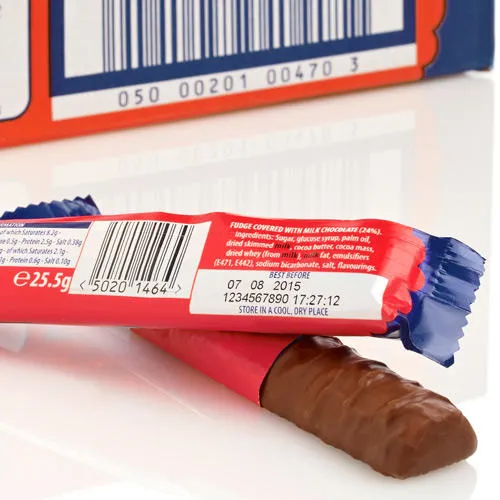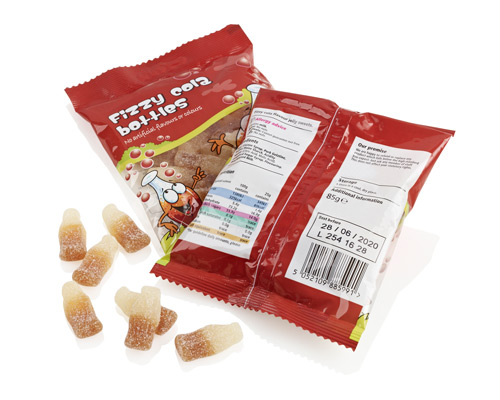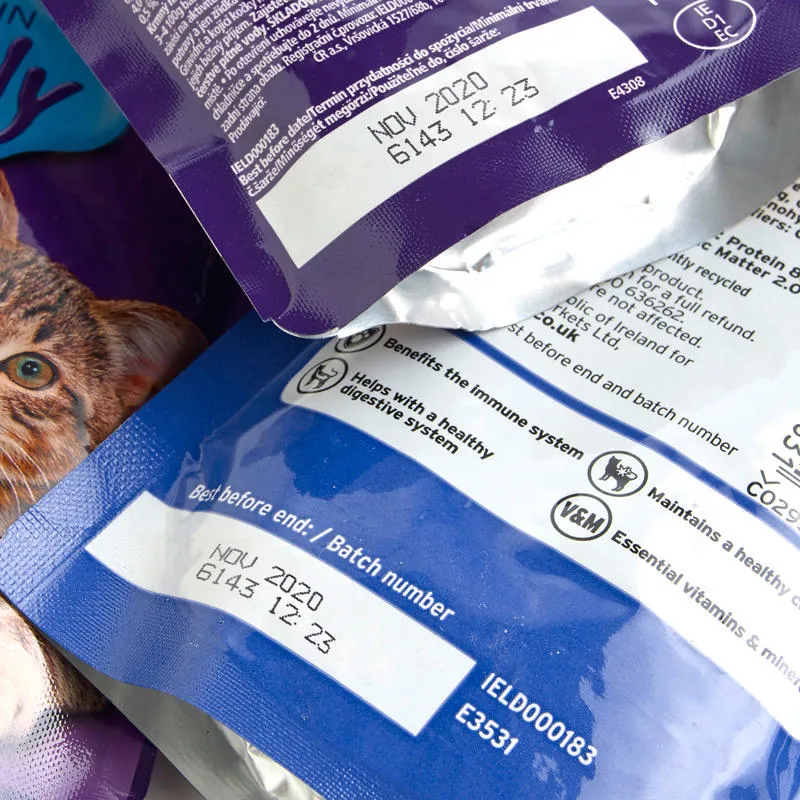You need only keep half an eye on the supermarket shelves to see that flexible packaging is big and getting bigger. As manufacturers increasingly turn to the latest packaging trend, your coding technology needs to be as flexible as the substrates passing through your production line.
$230 billion: that’s the value of the total market for consumer and industrial flexible packaging, according to new research from packaging market intelligence experts Smithers Pira. That figure is projected to grow at an annual rate of 4.3% to reach a total value of $283 billion in 2022. In short: the growing trend towards the use of flexible packaging shows no signs of slowing down.
Yet applying traceability and product identification codes onto flexible packaging can sometimes present challenges previously unseen with other packaging materials. In the case of jars and cans, coding always takes place after the package is filled and sealed.
The coding technology can cope with the curved or uneven surfaces. When it comes to flexible packaging the number of coding technology options increases depending upon the production environment. This means that where and when a product is marked on the production line can be different for specific coding technology.
What products use flexible packaging?
Candy and chips have long been tucked inside flexible packaging. That's the way it has been for decades in the packaging industry. Today, there is more than just candy and chips shipping in bags.
With the ever-changing tastes of younger customers, the demand for lighter weight packaging has only grown stronger. There is now a staggering diversity of products and each of them are adopting flexible packaging. Everything from:
- Coffee
- Wine
- Pasta sauce
- Cereal
- Salad
- Laundry Detergen
All is now found in flexible packaging and here at Domino, we're certain it will only grow as the form of the packaging also varies dramatically from stand up pouches, pillow bags, individual sachets and wrappers.
What’s the best coding technology for flexible packaging?
As production environments are pushed to produce more product per day and the variety of packaging designs increase, the coding technology needs to be as flexible as the material it is coding onto. Having fast, flexible and reliable coding technology is no longer a wish but a necessity to meet today’s modern production demands.
Traditional hot stamping and roller coders
When coding of flexible packaging went from being hand applied labels to on-line, hot stamping was one of the first methods used. Yet while it has its place in printing history, new technologies are making hot stamping commercially unviable. Hot stamping’s weakness lays with its static die based typeface, the highly manual job of cooling the coder and then physically changing the typeface character by character for each job, batch change, and shift change. This means that this technology has high downtime and is unprotected from human error. This potential re-work induced by human error, increased downtime for code changes, and the relatively short printing rolls, means that the overall OEE can severely impact your facilities productivity. Print quality can be inconsistent during the life of the typeface again enhancing the risk of reworks - raising production waste and decreasing output.
Also, as we move into a digital age, where customers often demand more interaction with the product or brand, this traditional technology can not produce QR codes and 2D data matrices that allow an enhanced product experience.
Out with the Old, In with the New
Transitioning from trusted legacy systems to the latest digital technology can feel daunting for any business owner. However, the reality is that it allows manufacturers to enhance output, boost efficiency and increase production capacity.
Believe it or not, in the end, all of these attributes will be good for the bottom line and will outweigh the original capital expenditure.
See how Dobson & Sons in the UK, a family-owned business with over 150 years of history, transitioned from old coding technology to digital thermal transfer overprinting with Domino:
Thermal inkjet coding
Thermal inkjet systems use solvent and water-based inks to print complex codes at line speeds of up to 300 meters per minute. The ability to easily integrate small TIJ print heads into both single lane and multi-lane applications makes it incredibly efficient for a variety of substrates.
It is also possible to use multiple print heads to deliver individual codes across the substrate surface from a single controller. That spells specific cost and productivity benefits.

There are few downsides to thermal Inkjet coding - for example ink jetting distance of ethanol inks is only up to a maximum of 3mm, so product handling has to be excellent in order to maintain the code quality; you always have to code prior to filling of the packaging.
Secondly a TIJ cartridge cannot contain harsh solvents that would benefit adhesion onto non porous films. Therefore it is a technology that may not be suitable for very glossy and shiny films. On the flip side however, TIJ offers benefits by delivering high speed and high quality codes (up to 600 dpi) with potentially reduced service and maintenance requirements.
The high resolution allows coding of machine readable codes. In particular QR codes are becoming an increasingly popular way to engage with the consumer. From an operations perspective, changing a TIJ cartridge is a process that is familiar to anyone who has a desktop printer at home.
When in doubt, Thermal Transfer
If it’s flexibility, speed and quality that you’re looking for, you will struggle to beat thermal transfer overprinting. TTO was designed and developed specifically for printing onto flexible packaging, whereas alternative coding methods have multiple uses. It allows you to print text, data, graphics, QR codes and logos over a large area at up to 300 dpi – switching between elements in subsequent prints if you wish.

It also allows for multi-line codes and large area variable data printing, making it adaptable for switching quickly between different types of flexible packaging substrate as well as different types of products being packaged. Because TTO technology is digital, you can store thousands of pre-prepared codes in the memory, unlocking potential time savings. It’s one of the reasons TTO is so popular in sectors with multiple SKUs and high output such as food and pharmaceuticals.
With 300 dpi digital real time printing, long ribbon rolls, and fast startup, TTO allows for increased production capacity and a reduction in potential coding errors.
>> 6 reasons every snack manufacturer needs TTO technology
>> Choosing a thermal transfer overprinter: 7 key considerations
Laser coding
Laser systems are unlike any other coding technology. They are fast. And when installed correctly, they provide outstanding clarity and code quality.
Yet laser systems aren’t ideal for every manufacturer. The upfront cost can be high in comparison to other types of coding. You also need to install safety infrastructure - such as guarding - to protect your production staff from exposure to optical radiation. However, what is often overlooked is that not all substrates are suitable for laser coding. Bearing in mind the higher initial costs of laser systems, why should they be considered? The simple answer is production capacity. If your production speeds are fast and your production rate high, then laser can give you a very competitive coding solution. The reduced consumables when coding with lasers potentially provides a faster return on investment in the long term when compared to traditional coding technologies. The key for laser coding is to work with a technology expert - it is essential that your chosen supplier not only understands the laser product but also how substrates affect coding performance.
>> Keeping your staff safe when coding with lasers
Continuous inkjet
There’s a reason continuous inkjet applications appear across so many different industries. The best systems are just so flexible. They are fast, they offer clarity and specific models are built to withstand the rigors of harsh production environments.
Additionally they enable you to work with a huge range of inks - including those that are UV, washable or moisture resistant. That massive assortment of inks gives you a lot of flexibility in terms of adding security components to your packaging or acquiescing with packaging design or branding.
Similarly, CIJ also allows for coding onto the finished product, so it can be easily retrofitted to existing production lines. However if you need to print 2D data matrices at a clip, continuous inkjet may not be suitable for your production requirements, depending on the requirement.

>> 5 key considerations when installing coding technology
Ink and consumables
Most industries will have a number of legislations to protect consumer health when using different types of packaging. Although codes only make up a small amount of the overall packaging, ensuring that the ink or ribbon you use are safe for the consumer is essential in sectors such as food. Flexible packaging is no different.
Working with suppliers who have this expertise and have this embedded in their thinking can give you the confidence that their coding is compliant.. Terms such as GMP are often used but companies which are aligned with industry certifications (GFSI - Global Food Safety Initiative) or independant industry standards (EuPIA - European Printing Inks Association) are areas to look out for..
Which digital coding technology is right for you?
There are a number of options available when it comes to coding onto flexible packaging. Finding the right technology for you will depend on several factors within your production environment. These may include the substrates you are working with, the products you are making, the types of code you need to apply and the speed of your production lines.
Yet taking the time to research - and speaking with the experts about - the available products is worth it. Finding the technology that best fits your production environment will help you generate the optimum ROI for your business and maximise the benefits you receive from faster, smarter and more efficient coding operations.
Domino is a global leader in coding and printing technology and has created some of the most advanced systems available.. If you would like expert support in finding the digital coding technology that’s best for your business, please get in touch.